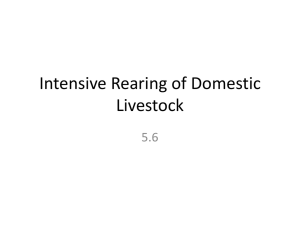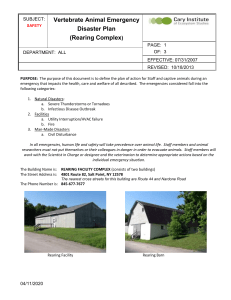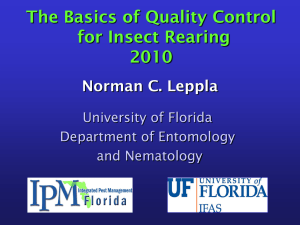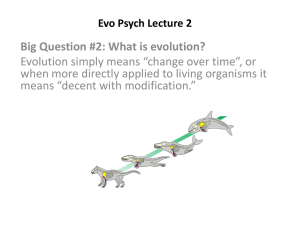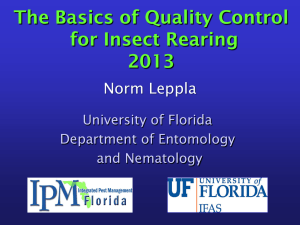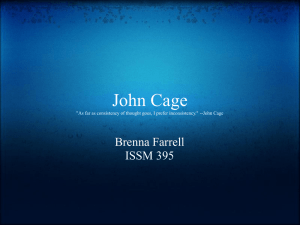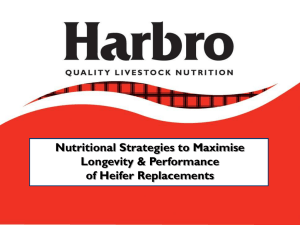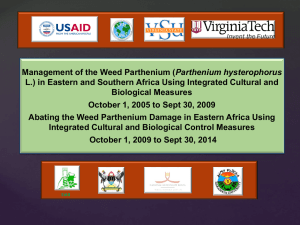Mass Rearing of the biological control Agent Zygogramma
advertisement
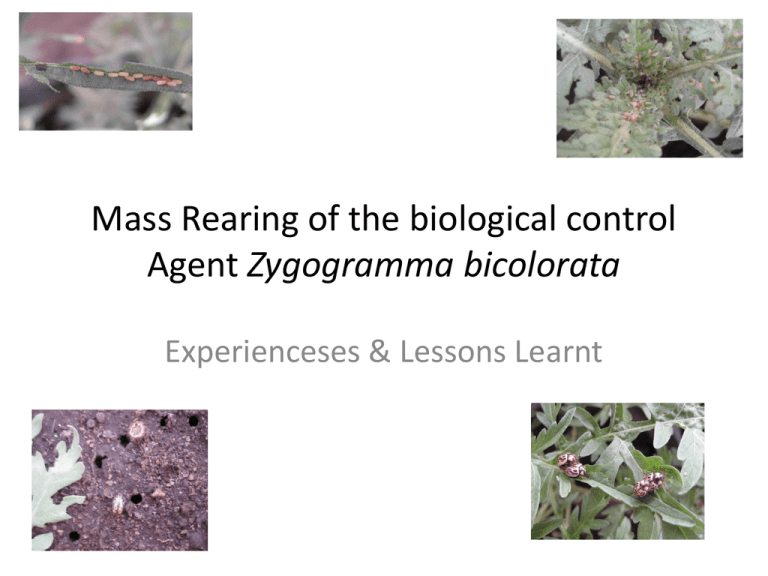
Mass Rearing of the biological control Agent Zygogramma bicolorata Experienceses & Lessons Learnt Mass rearing Cont`d • The agent was kept at Ambo quarantine facility after being Introduced from South Africa in October 12, 2007. • After conducting host range test, environmental impact assessment document was prepared & sent to MoA • Approval from MoA obtained on June, 2012 • Visit by representatives from MoA, EPA & IBC took place in October 02, 2013 Mass rearing Cont`d • Preparation for multiplication – Multiplication site is located within a farmers` association compound in Wollinchitti town, about 125 km east of Addis Ababa Original Site After clearing – It is 46 x 16.5meters – Was enough to erect 5 breeding cages & a Nursery and a water tanker Mass rearing Cont`d • Mesh net and pots arrived at Wollinchitti on December 25, 2012 • Purchase of farm tools including two water tankers completed at end of January, 2013 • Installation of water pipe in early February, 2013 Mass rearing Cont`d • Because of shortage of water from the source we were getting very little water • Got connected to a reliable water system, that supplies water to the rural community of the Woreda, on February 13, 2014 Mass rearing Cont`d Erection of Breeding cages & a Nurserycompleted end of January 2013 Nursery Nursery & Breeding cages 3000 lts. Water Tanker Mass rearing Cont`d Whole area fenced with barbed wire with 15 cm spacing Main Entrance Door With lock Gravel on surface inside & outside cages Second Door Mass rearing Cont`d Water Tanker 3000 and 5000 lts. capacity store Toilet & hand wash Mass rearing Cont`d Dealing with high temperature Nursery 5 x 10m Shading of breeding cages Mass rearing Cont`d • Multiplication of Zygogramma in 2013 – Started with a batch of 60 pairs of Zygo. that was brought from Ambo on June 25, 2013 Mass rearing Cont`d Adults started laying eggs and some eggs have started hatching when flooding hit the area on July 02, 2013 Mass rearing Cont`d Potted plant approach Egg laying, Larval Development & Adult Emergence set up Cage 1 Egg laying 12 vigorous parthenium plants in pots 50 pairs of Adults released & kept for 3 days CAGE 1 Mass rearing Cont`d CAGE 2 Larval Development Larva are left to feed by changing plants as needed Remove smaller size larva & place on new plant Place soil/sand mixture at bottom of old pot Leave old pot until most larva enter soil Cut back the plant & place in adult emergence cage Mass rearing Cont`d Cage 3 Adult Emergence • Pots are kept wet • Pots checked for adults twice a day a week after being placed in cage • Adults are taken back to cage 1 to start the process all over again Mass rearing Cont`d Surface planted approach Mass rearing Cont`d • In 2014 we used the two approaches side by side • Plan was to produce 4000 adults in one of the cages and distribute these in the four cages to eventually produce 40000 adults by mid July • But most of the initial Zygogramma culture were destroyed by Lizards Lizards` hiding cracks Remains of Zygogramma After Lizard attack Mass rearing Cont`d • Rearing continued with remaining adults • Within one cage (Cage 4) on benches 300 egg laying adults, placed in a small cage containing four plants in pots for one day, produced on the average 425 eggs Adults remain on plants all the time thereby producing more eggs larva are removed and transferred in two other cages and others were left on plants to pupate in pots Mass rearing Cont`d • Second Approach releasing adults on plants grown on surface of Breeding cages (cages 1 and 4) 3 plots each about 1m wide, rows 20-25cm spacing Woreda involvement & awareness creation • Involvement of Woreda Agriculture office • Awareness creation Challenges • Water problem before February 13, 2014 Pipe installed but very little water Transport water using Horse cart & pick up vehicle Challenges • Weather condition On human beings On growth & development of parthenium Challenges Aphid infestation Under side Mealy bug Infestation Upper side Young Shoots Ants Large size Ants Immediately after Planting Larva being attacked ant Lizards & Rats Remains of adults after Lizard attack Some observations Green looper feeding on Parthenium Dorsal view of Adult Side view of Adult Some observations Some kind of larval parasite Parasitized Larva? Diseased Larva Pupa Mating Adults Some observations • Aphids and its parasites Some observations Extra seedlings from surface grown plants can be transplanted And used in pot rearing Make use of parthenium seedlings Around rearing site Some observations • Chicken as predators of Mealybugs Mass rearing cont`d…. • Comments, suggestions & lessons learnt – Collect enough seeds at the right time – Site should be built away from any source of threat – Don`t ever start rearing without reliable water source – Be present as frequently as possible & make observations all the time – Take care of pests particularly Aphids and Mealy bugs Mass rearing cont`d…. • Use benches for rearing in pots • Make sure you have enough supply of parthenium seedlings • Use combination of the two approaches • Use wood Ash against ants • Need for some Entomological tools – Insect rearing cages, preservatives, pins etc. Mass rearing of Zygogramma

